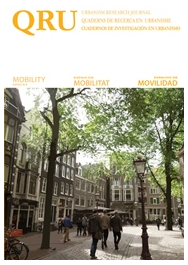Los pasajes del BRT en Bogotá: los puentes peatonales del sistema “Transmilenio” como dispositivos que generan nueva urbanidad
DOI:
https://doi.org/10.5821/qru.9606Abstract
When the first expressways of the Transmilenio system were constructed in Bogota, pedestrian bridges became crucial elements that support the system by linking directly pedestrians and public transport stations. Pedestrian bridges acquired a new role, not only as connecting hubs of the system but also as originating spaces where a new urbanity is generated. Bridges are also devices that facilitate access from the stations to neighborhoods and to other means of transport; they allow access to new equipment, from commercial services to street vending. The object of this paper is to analyze the pedestrian bridges and the public space of the Transmilenio system in Bogotá, in order to understand its logic as a connector between borders and as devices that generate a double experience in people: they guarantee their access to public transport and therefore to the city, and at the same time its function as a new social space that integrates mobility, connections and activities at local level.Downloads
Issue
Section
License
Those authors who have publications with this journal, accept the following terms:
a. Authors will retain their copyright and guarantee the journal the right of first publication of their work, which will be simultaneously subject to the Creative Commons CC BY-NC-ND-4.0 recognition license that allows third parties to share the work provided that its author and its first publication are indicated in this journal, but they cannot be changed or used commercially.
b. Authors may adopt other non-exclusive license agreements for the distribution of the version of the published work (eg: deposit it in an institutional telematic archive or publish it in a monographic volume) provided that the initial publication in this journal is indicated.
c. Authors are allowed and recommended to disseminate their work through the Internet (e.g. in institutional telematic files or on their website) before and during the submission process, which can lead to interesting exchanges and increase citations. of the published work. (See The effect of open access).













